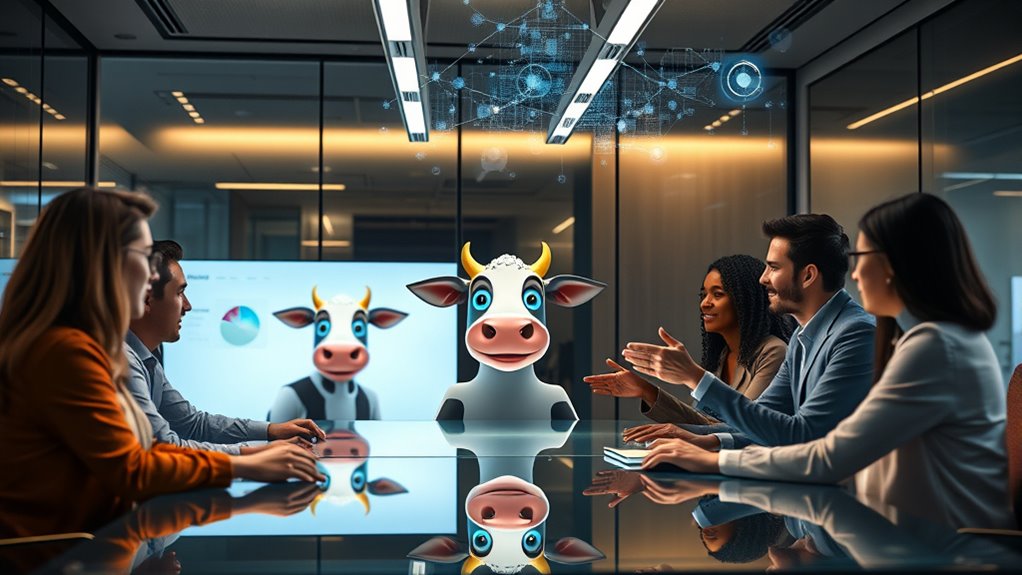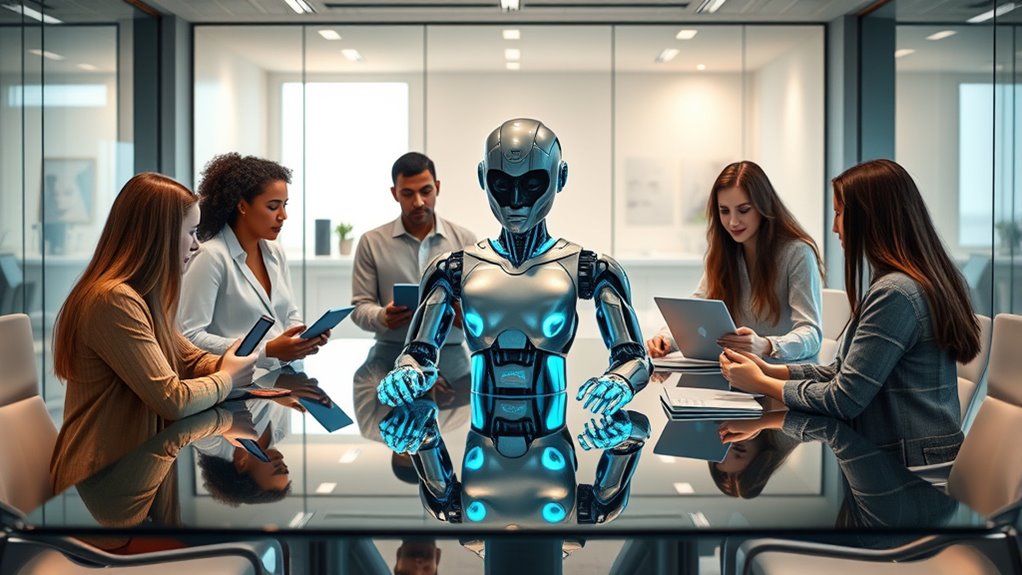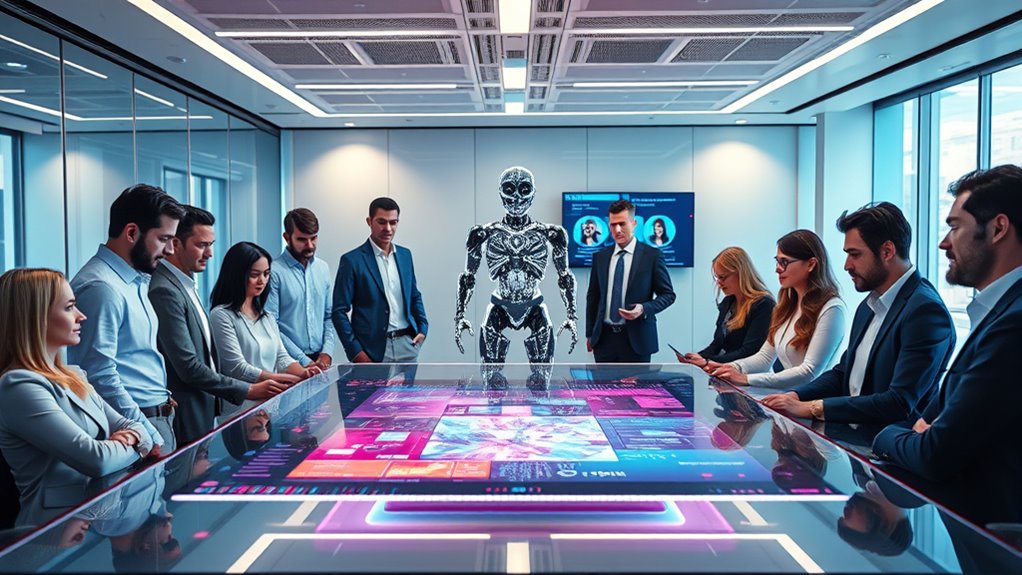As ChatGPT becomes a true team member, you’ll find AI tools like it are transforming workplaces rapidly. Adoption has doubled recently, with over a quarter of employees actively using AI daily to boost productivity, handle complex tasks, and improve decision-making. AI co-workers automate routine work, support creativity, and enhance collaboration across industries. If you want to discover how these AI teammates are shaping the future of work and what you should do next, keep exploring these exciting changes.
Key Takeaways
- AI coworkers like ChatGPT automate routine tasks, enhancing productivity and enabling employees to focus on complex, strategic work.
- Integration of ChatGPT as a team member improves data analysis, decision-making, and document processing efficiency.
- AI co-workers support continuous learning and skills development, fostering a culture of agility and adaptability.
- Challenges include cybersecurity, AI inaccuracies, and workforce skills gaps that organizations must address for successful adoption.
- The rise of AI coworkers signifies a shift towards collaborative human-AI teams, transforming workplace workflows and organizational dynamics.
The Growing Presence of Generative AI in Workplaces

The presence of generative AI in workplaces is rapidly expanding, transforming how businesses operate across various industries. Adoption rates doubled from 2023 to 2024, reaching 65% in some sectors, with 28% of employees actively using AI tools. Most usage occurs in customer service, marketing, and IT, where content creation, analysis, and automation thrive. Daily engagement varies: around 24% used AI last week, with over 10% doing so every workday. Larger companies are leading the charge, but many still experiment or pilot AI solutions. While confidence in AI’s potential is high—70% of leaders believe automation will surpass traditional methods—adoption remains cautious. Challenges like data security and skill gaps slow full integration, creating a landscape of rapid growth mixed with cautious implementation. As organizations seek to improve employee well-being and productivity, some are exploring AI-powered tools to support mental health and streamline workflows comfort and support solutions. Increasing awareness of training needs is also guiding how companies implement these new tools to ensure effective adoption. Moreover, understanding the limitations of AI systems, such as potential biases and errors, is crucial for responsible deployment. Recognizing the importance of technical specifications can help organizations choose appropriate AI tools that meet their operational requirements.
Key Benefits of Integrating AI Co-Workers

Integrating AI co-workers can considerably boost your workflow efficiency by automating routine tasks and freeing you to focus on more strategic work. They also enhance data analysis, providing precise insights that drive better decision-making. As a result, your team can operate more smoothly and deliver higher-quality results faster. Furthermore, the adoption of AI can lead to improved team collaboration, fostering a more innovative and adaptable work environment. Additionally, leveraging AI content clusters can help organize and optimize your team’s knowledge base, ensuring consistent messaging and expertise across projects. Recognizing the importance of AI security and addressing potential vulnerabilities is crucial to maintaining trust and safety as AI becomes more integrated into daily operations. Addressing organizational guidance can help alleviate employee hesitations and promote smoother AI adoption. Moreover, understanding how personality traits influence team dynamics can facilitate better integration of AI tools, making collaboration more effective. However, despite these benefits, many employees remain hesitant to adopt AI due to limited organizational guidance and concerns about job security public perception of AI’s impact on employment.
Boosts Workflow Efficiency
AI co-workers substantially enhance workflow efficiency by automating routine tasks and streamlining processes. With generative AI tools, business users boost their throughput by 66%, and support agents handle 13.8% more inquiries per hour. Business professionals can complete 59% more documents each hour, while programmers code over twice as many projects weekly. Automation reduces errors by 49%, saving time and increasing accuracy. It automates repetitive tasks, allowing your team to focus on higher-value activities. Dashboards analyze workflow efficiency and employee performance, helping you identify bottlenecks. Customer support AI provides instant responses and converts conversations into helpful articles, speeding up knowledge sharing. Additionally, incorporating sound healing science can support employee well-being and reduce workplace stress, further enhancing productivity. Overall, AI integration makes your workflows faster, more accurate, and less error-prone, considerably elevating your team’s productivity.
Enhances Data Analysis
Leveraging advanced data analysis capabilities with AI co-workers allows you to uncover insights faster and more accurately. You can automate complex coding tasks, process large datasets efficiently, and identify key trends without manual effort. AI tools automatically detect data structures, making uploads seamless and reducing setup time. Additionally, they generate custom visualizations—charts and graphs—on demand, helping you interpret data quickly. Supported file types and upload options here further streamline the workflow. Here are some key benefits:
- Automates coding and analysis, saving time.
- Handles large, complex datasets effortlessly.
- Provides instant, tailored visual insights.
- Supports natural language queries for easy interaction.
- Recognizing data formats and file compatibility ensures smooth integration.
Overcoming Challenges in AI Adoption

Overcoming the challenges in AI adoption requires addressing multiple interconnected issues that can hinder progress. Safety, risk, and regulation are top concerns—cybersecurity worries 51% of US employees, while 50% are concerned about inaccuracies in generative AI. Privacy and intellectual property concerns affect many, with 43% and 40% respectively, and regulatory compliance remains a hurdle for 28%. Talent shortages and skills gaps also slow adoption; 68% of leaders struggle to find AI talent, and half of employees will need new skills by 2025. Trust issues persist, with 52% of workers worried about job impacts and 79% lacking confidence in responsible AI use. Data quality, infrastructure, and policy gaps further complicate implementation, making it essential to develop all-encompassing strategies to overcome these barriers. Additionally, ensuring robust AI security measures is vital to safeguarding sensitive data and maintaining organizational trust.
Emerging Trends Shaping the Future of AI in Business

As AI adoption accelerates, you’ll see more businesses integrating advanced AI applications to streamline operations and innovate faster. To stay competitive, you’ll need to focus on developing new skills in AI, data science, and human-AI collaboration. Embracing these trends now will position your team for future success in an evolving AI-driven landscape.
Increased Adoption Rates
Have you noticed how quickly AI tools like ChatGPT are becoming essential across industries? Adoption is skyrocketing, transforming how businesses operate. Here are some key trends:
- Industry Impact: Travel, retail, IT, healthcare, and automotive sectors see significant financial benefits, influencing hundreds of billions of dollars.
- User Growth: ChatGPT surpassed 1 million users in just 5 days and now has 400 million weekly users, with billions of visits monthly.
- Cost Savings: Around 25% of companies save between $50,000 and $70,000 by integrating ChatGPT into their workflows.
- Widespread Usage: Nearly half of users leverage ChatGPT for learning or fun, with increasing adoption across age and income groups. User engagement continues to rise, with average visit durations exceeding 8 minutes.
This rapid growth signals AI’s pivotal role in shaping future business landscapes.
Advanced AI Applications
The rapid adoption of AI tools like ChatGPT has paved the way for more advanced applications that go beyond simple content generation. You’ll see agentic AI, which can independently solve problems, process complex information, and learn from its environment. Unlike traditional AI, it can make real-time decisions and handle multi-step workflows without human input. Collaboration among multiple AI models allows these systems to accomplish sophisticated goals across different tasks. In industries like healthcare, AI now diagnoses diseases with high accuracy and supports 24/7 patient care, while in finance, automated trading and fraud detection improve security and efficiency. These emerging AI trends—autonomous agents and automation—are transforming business operations, giving you smarter, faster, and more adaptable tools that drive competitive advantage. Additionally, advancements in AI are making systems more versatile and responsive, enabling businesses to adapt swiftly to changing market demands. As AI continues to evolve, it is increasingly integrated into business workflows, streamlining processes and enhancing decision-making capabilities.
Skill Development Needs
To effectively harness AI’s potential in your business, developing the right skills is essential, especially as emerging trends rapidly reshape the workplace. You need to focus on continuous learning and adapting to new AI tools. Here are key skill development needs:
- Formal AI training and upskilling to bridge the gap between awareness and practical application.
- Building augmented human skills like critical thinking, creativity, and ethical judgment to evaluate AI outputs responsibly.
- Mastering AI-powered personalized learning systems for ongoing development tailored to your role.
- Developing proficiency in prompt engineering, data literacy, and problem-solving to validate AI-generated results.
- Understanding the Tools and Techniques used in personal development, such as journaling and meditation, can enhance your ability to adapt and integrate AI effectively into your workflows. Additionally, gaining insights into Natural Language Processing (NLP) can help you better leverage AI-driven customer interactions and sentiment analysis for business growth.
How AI Is Transforming Industry-Specific Tasks

How is AI revolutionizing industry-specific tasks across different sectors? In automotive, AI powers autonomous vehicles, with the market expected to hit $36 billion by 2025. In customer service, virtual assistants are becoming more common, with 70% adoption anticipated by 2023. Healthcare providers have adopted AI in over half of their operations, boosting diagnostics and treatment. Manufacturing investments in AI are projected to reach $15.7 billion by 2025, streamlining production. Financial services see 84% of executives rating AI as critical to success, enhancing risk management and analytics. Across industries like aerospace, agriculture, and construction, AI-driven analytics is widely adopted—up to 85% in aerospace. These advancements are transforming how sector-specific tasks are performed, making processes faster, smarter, and more efficient. Additionally, understanding personality traits can help tailor AI interactions to better suit individual user needs.
The Impact of AI on Workforce Skills and Culture

As AI continues to reshape industries, workforce skills and workplace culture are undergoing rapid transformations. You’ll find that the demand for AI skills has doubled since 2016, and by 2030, 70% of job skills will change. To stay relevant, you’ll need to focus on upskilling and reskilling, especially in areas like AI literacy and digital collaboration. Here are key points to consider:
- Skills like problem-solving, creativity, and adaptability are more valued than ever.
- Over half of employees will require significant reskilling by 2025.
- Most workplaces support learning AI skills, fostering a culture of continuous growth.
- AI adoption accelerates cultural shifts, emphasizing ethical judgment and collaboration.
Remaining agile and open to learning is essential as AI influences both your skills and workplace environment.
Strategies for Seamless AI Integration in Teams

Integrating AI seamlessly into your team’s workflows is essential for maximizing its benefits without disrupting productivity. To do this, focus on aligning AI tools with existing systems, emphasizing automation of repetitive tasks, and ensuring compatibility. Provide targeted training, especially formal general AI programs, so employees can adapt easily. Address concerns about job displacement openly, offering retraining and clear communication. Prioritize gradual implementation, allowing time for adjustment.
| Strategy | Focus Area |
|---|---|
| Seamless Workflow Integration | Compatibility and automation |
| Effective Training | Tailored, accessible AI education |
| Clear Communication | Address fears and explain AI benefits |
| Gradual Deployment | Phased implementation to reduce disruption |
| Long-term Investment | Focus on scalability and future growth |
Frequently Asked Questions
How Can Small Businesses Effectively Implement AI Coworkers?
You can effectively implement AI coworkers by identifying repetitive tasks like scheduling, invoicing, or customer support that AI can handle efficiently. Focus on integrating AI tools into areas like marketing and CRM to boost productivity. Train your team to use these tools confidently, maintain transparency about AI use, and monitor performance regularly. This approach helps you maximize AI’s benefits while ensuring smooth, trustworthy adoption within your small business.
What Are the Best Practices for Training Staff on AI Tools?
You should focus on providing formal, job-specific training that aligns with your organization’s goals. Use a mix of on-the-job practice, online courses, and digital simulations to boost skills effectively. Encourage a continuous learning culture, and establish clear guidelines for AI use to guarantee safety and confidence. Regularly measure training success and adapt your approach to keep staff engaged and comfortable with AI tools, maximizing their impact on performance.
How Does AI Impact Employee Job Satisfaction and Morale?
AI can dramatically boost your job satisfaction by automating boring tasks and giving you more control over your work. When integrated well, it feels like a gust of fresh air in a stale office, making your day more engaging. It also offers opportunities to develop new skills, which can skyrocket your confidence and career growth. However, if poorly implemented, it might lead to loneliness or stress, hurting morale instead.
What Legal Considerations Exist When Using AI in the Workplace?
When using AI in the workplace, you must consider legal requirements like bias audits, transparency, and employee notification. You’ll need to guarantee compliance with evolving state and federal regulations, such as Colorado’s CAIA and California’s SB 7. Regularly conduct impact assessments, maintain detailed documentation, and include human oversight in AI decision-making. Staying updated on legal changes and collaborating with experts helps protect your company from litigation risks and promotes fair, transparent AI use.
How Can Companies Measure AI Integration Success?
You can gauge AI integration success by focusing on key indicators like process throughput, which shows how much faster your workflows become. Keep an eye on cost savings and resource utilization to see how efficiently AI uses resources. User experience metrics like task success rates and satisfaction scores reveal how well your team adapts. ultimately, monitor business impact through ROI, revenue growth, and time-to-market to celebrate your AI’s contributions.
Conclusion
As you embrace AI co-workers like ChatGPT, remember that you’re stepping into a new chapter—much like Icarus daring to fly higher. With thoughtful integration, you’ll gain access to efficiencies and innovation, transforming your team into a modern-day Renaissance. Just stay grounded, adapt swiftly, and keep your focus on human creativity and connection. In this evolving landscape, your willingness to evolve will be the key to soaring—without risking a fall.









